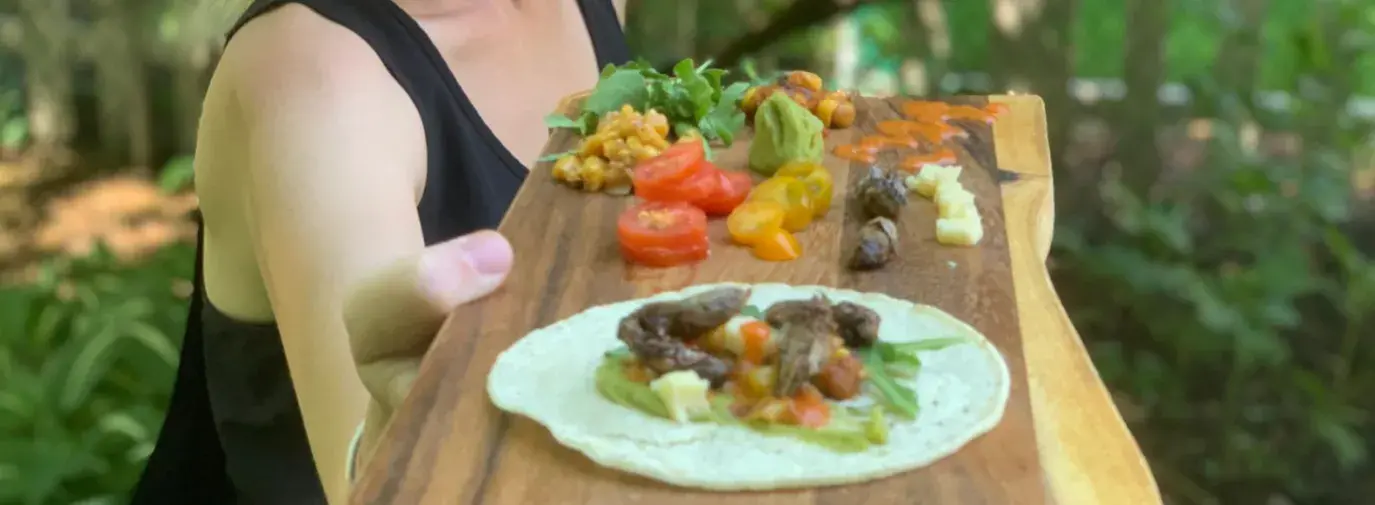
Almost two billion people worldwide partake in the culinary delight of bugs. In Thailand, fried caterpillars are common treats at street markets. In Mexico, cooked grasshoppers are bar snacks and taco fillings. And in Uganda, flying African termites, which have more protein than vertebrate meat, are eaten à la carte.
Yet many Americans are revolted by the idea of bugs for dinner. In a warming world, insect cuisine may become commonplace— to fight climate change, and because it’s tasty.
Katydid Cakes, Anyone?
The Food and Agriculture Organization estimates that 25-50% of Native American tribes had traditions around entomophagy (the practice of eating insects) before the 18th century. The Cherokee would enjoy fried cicadas, the Kitanemuk would eat red harvester ants as a hallucinogenic, and the Ute near Great Salt Lake shared katydid cakes with Mormon settlers during icy winters.
Dr. Cortni Borgerson, a Montclair State University professor researching insect-eating as a means of wildlife conservation, explains that American settler hesitance with entomophagy has to do with exposure. If people saw bugs as part of a regular meal, like French fries accompanying a burger, or in the meat aisle alongside pork and chicken, it would be normal.
“Most things that we like to try are introduced to us by family and friends,” says Borgerson. Without that, we are cautious to try something new.

Additionally, there is a geographic piece to the cultural puzzle. In northern latitudes, bugs die off for half the year, whereas cultures around the equator see bugs year-round, establishing ample time to experiment with entomophagy.
“When we do encounter insects, we’re not encountering them on our plates, but we are encountering them as taking our food away through spoilage or pests in our home—as opposed to this exciting new source of incredible food,” says Borgerson.
Protein Shake with a Side of Sustainability
Mounting concern over global food insecurity and the climate crisis are causing Americans to reconsider their protein sources. While highly processed plant-based meats are grabbing headlines as climate friendly options, one-third of Americans are receptive to a different protein: cricket-based foods.
Crickets have a much better environmental footprint than livestock. Insects get most of their moisture needs from food, using 95% less water than conventional animal agriculture. They are 20 times more resource-efficient than cows, producing 80% less methane, and release far less ammonia than pigs, which can pollute waterways and soil.
Industrial soy agriculture—a high-protein plant option—is better than livestock when it comes to resource management, but soy production is connected to deforestation and biodiversity loss in Brazil’s Amazon Rainforest, as well as high pesticide use and genetic engineering. Comparatively, crickets can be grown indoors in sealed facilities and stacking habitat enclosures to be even more space-efficient. Indoor growing promotes food security in cities affected by climate change-related transport disruptions.
Sarah Schlafly started the food company Mighty Cricket with these points in mind, offering protein powders, flour, and oatmeal made from ground crickets. Schlafly notes that outdoor fitness enthusiasts gravitate to her products.
“Mountain bikers, rock climbers, trail runners—they’re already in nature,” says Schlafly. “Bugs don’t really ick them out because they’re always getting them in their face anyway, and they’re very passionate about preserving their ‘playground.’ I think it’s a combination of the [high protein content] they can get from the products with that sustainability piece.”
Crickets seem to be a palatable option for Americans because they are not associated with spoilage in the same way other bugs are. Crickets are reminders of delicate chirping on calm evenings and cute cartoon sidekicks in Disney movies. Many of Schlafly’s customers don’t just buy the products because of the environmental benefits, but because they like the taste, she says.
A New Take on Taco Tuesday
It’s hard to predict when insects will become a regular part of the American diet, says Schlafly, but change is happening. Restaurants across the country are offering Americanized takes on cultural dishes. Los Angeles is home to many chapulin restaurants (derived from the Nahuatl word chapolin for grasshopper) such as Guelaguetza and Expresion Oaxaqueña, and New York City’s The Black Ant, a modern Oaxacan-style restaurant, serves black ants on guacamole and espresso martinis.
“Those are actually what I recommend when someone’s like, ‘Oh, I want to try a bug for the first time,’” says Borgerson. “Get a chapulines taco, get some black ant guacamole because you get a citrusy profile versus a chicken profile with a nutty edge.”
While protein powder is one way to integrate insects into your diet, Borgerson hopes more people try insects in plated dishes. Seeing bugs served next to chips or on a taco helps to normalize it as food.
“If you think of things like sushi, tacos, and pizza, we’re constantly turning any neat, exciting food in the world around, and then finding what it means to be American in that place,” says Dr. Borgerson.
Americanizing entomophagy has already started. Salt & Straw, the Pacific Northwest ice cream-favorite served chocolate-covered crickets and toffee-brittle mealworms in one of its seasonal Halloween ice creams. The company takes inspiration and sources its bugs from Monica Martinez, who is on a mission to share the joy of entomophagy with Americans by selling bugs grown on her urban farm, Don Bugitos, in Oakland, California.
For most Americans, the world of insect cuisine is a new frontier. But giving a bite a try is a chance to explore exciting new flavors and advance environmental sustainability in a warming world. Look for restaurants serving bugs near you, try a cricket protein shake or ice cream, and if you like it, share it with your family and friends.
Not ready for bugs yet, or practicing veganism? Like insects, plant-based proteins are climate-friendly alternatives to meats like beef, chicken, and pork. Tofu, tempeh, seitan, lentils, beans, and nutritional yeast are great contributions to a tasty meal.







